
by Samantha Kennedy | Apr 10, 2019
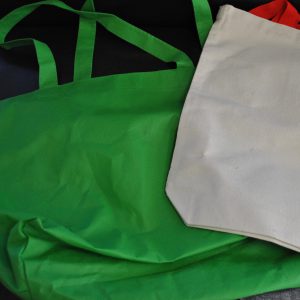
One way to be more sustainable when shopping for groceries is to use reusable shopping bags. They’re durable and sturdy and can help reduce the number of plastic bags that end up in the landfill each year. (Photo source: Samantha Kennedy)
Sustainability should not just be a buzzword during Earth Month. The fact that everybody either shops for or eats groceries means the whole grocery shopping experience is a good time to reflect and improve upon what we can personally do to embrace issues of sustainability.
This year in April, the Earth Month theme focuses on Returning to Nature. There is no better place to start a quest for personal sustainable improvement than the grocery store! Grocery shopping truly embraces the three main areas of sustainability: environmental, economic, and social. In fact, it has been well documented that the average family wastes about 25% of the food it purchases. (Much of this ends up in a landfill and creates problems of its own.)
With a bit of forethought, meal planning before grocery shopping can help individuals and families apply sustainable best practices for environmental, economic, and social well-being. In fact, many of the principles of sustainability can be effectively applied to both meal planning and grocery shopping.
RESPECT yourself. Good nutrition is one of the keys to a healthy life. Improve health by keeping a balanced diet. Vow to make healthier food choices for personal health and the environment.
REFUSE to use food products that do not fit your principles of sustainability. This may mean buying food with less packaging, eating more locally-grown fruits and vegetables, or looking for foods labeled as more responsibly sourced.
REDUCE the amount of food thrown out. Planning meals ahead of time and writing out a grocery list are excellent ways to start living sustainably. Planning not only saves money on groceries, it can save time and decrease the amount of personal food waste a family contributes. (Remember, freezing products can prolong their life, so if you find that you’ve overbought, try preserving some of your bounty for later use.) Reducing the number of trips to the grocery store also can help save on fuel and transportation costs.
REUSE /REPURPOSE food for another occasion. Careful meal planning helps ensure that leftovers from one meal can be incorporated into the next one, thereby reducing food waste.
RETHINK! Healthy, nutritious, delicious, and inexpensive grocery choices can be found in every food group. Not all food has to be prepackaged. In fact, with a bit of planning, dinner can be on the table in 15 minutes. (That’s less time than it takes to wait in line at a fast food restaurant.)
BE RESPONSIBLE! Use what you buy.
Stock up on low-cost healthy grain products like whole-wheat noodles, brown rice, and store-brand cereals and oatmeal.
Purchase fruits and vegetables that are in season and cost less. In addition, do not forget that frozen, dried, and canned fruits and vegetables can play an important part in meal planning.
Buy the largest size you can effectively use before it reaches the expiration date – and look for the items with the latest dates. Purchase store brands or generic brands whenever possible. Keep in mind smaller containers tend to cost more, no matter what the food group. Buying larger packages and dividing them into smaller portions can save money and reduce the amount of packaging that ends up in the landfill. Investing in small, reusable storage containers will save money and reduce waste in the end.
Practice Meatless Monday. The protein group provides inexpensive protein sources like beans, lentils, and eggs, which can be substituted for meat in many meals.
Protein does not have to be the most expensive item purchased. Consulting the store’s weekly sales flyer during meal planning can help you plan meals around meat and poultry items that are on sale.
Prepare food your family will actually eat. There are two schools of thought here: preparing just enough for one meal or preparing big-batch recipes that provide leftovers which can be frozen for later use. Either practice can be sustainable. Freeze leftovers only if you’re going to use them. Otherwise, cut down on the amount of food cooked to help reduce food waste.
Learn how to cook. Prepare and eat more meals at home. It is sustainable, good for you, and delicious. Meals cooked at home are more nutritious, less expensive, and result in less overall waste, such as packaging.
Two additional ways to be more sustainable when grocery shopping are to use reusable shopping bags and to stop using single-use plastic produce bags. Plastic grocery bags choke our landfills and end up in our water bodies. They are not biodegradable and can last thousands of years virtually intact. Reusable shopping bags are made from recycled materials and can drastically reduce the number of plastic bags that end up in the trash each year.
For more information on making your grocery shopping more sustainable, check out these related articles:
Freezing: Nature’s Pause Button (UF/IFAS Extension)
What’s in your FREEZER? (UF/IFAS Extension)
Best Practices for Shoppers at the Farmers’ Market (UF/IFAS Extension)
Sustainable Grocery Shopping (University of Northern Iowa)
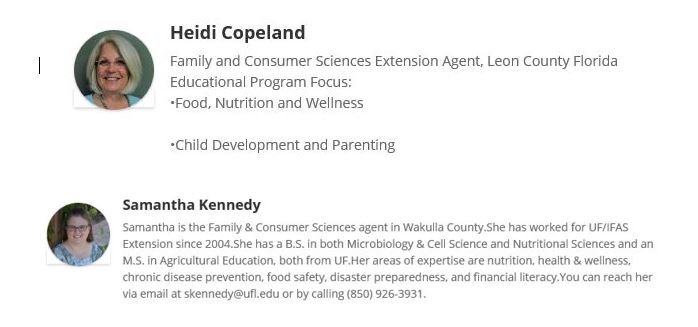
UF/IFAS Family and Consumer Sciences Agents Heidi Copeland and Samantha Kennedy
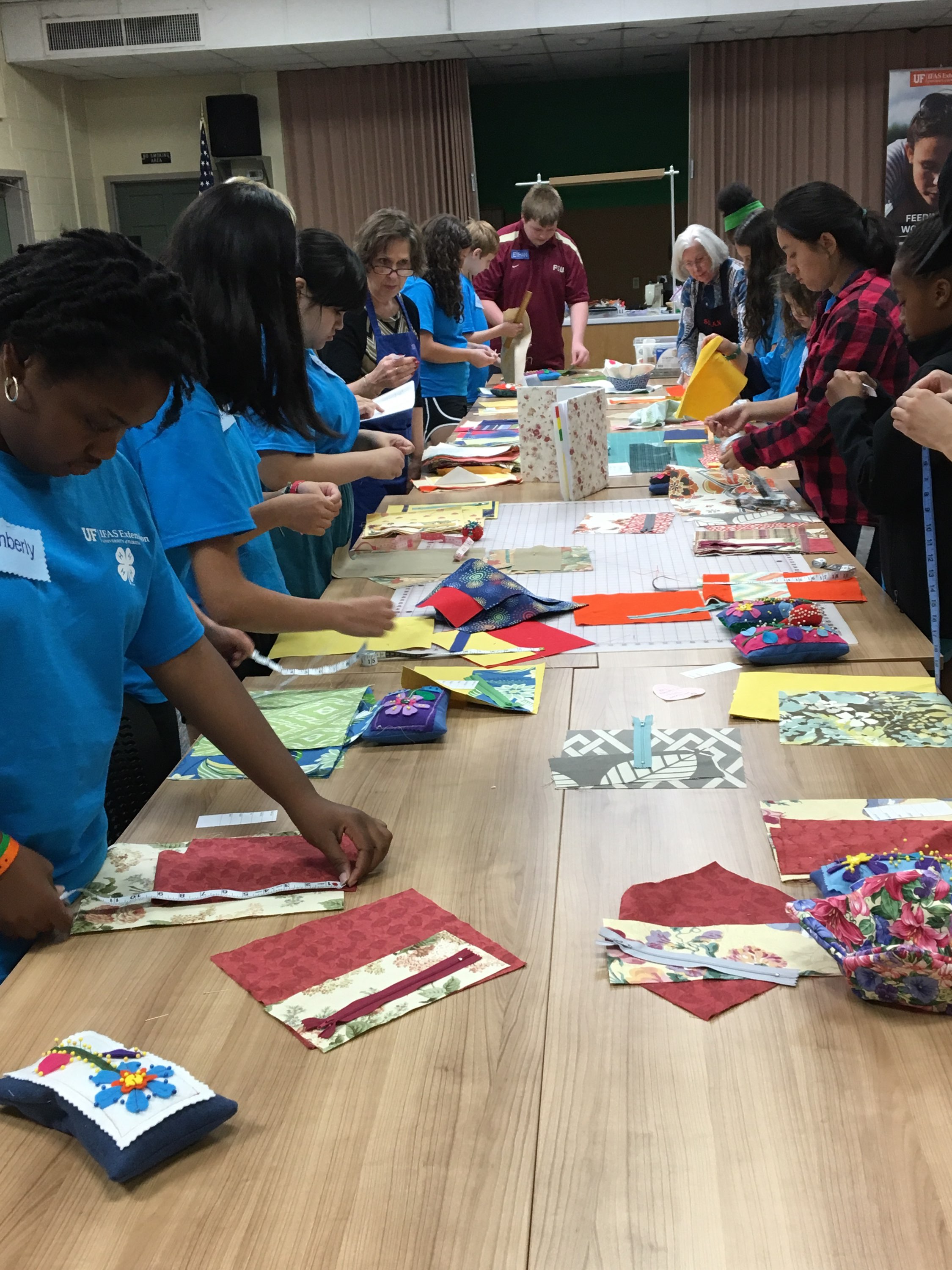
by Heidi Copeland | Jul 26, 2018
Have you ever read the book Something from Nothing, by Phoebe Gilman? It is a wonderful story, with a sewing theme, of sewing/creating something beautiful over and over again. My fervent hope is that the 4-H sewing camp participants feel the same way about all of their creations generated during sewing camp!
Recently, the Tallahassee Chapter of the American Sewing Guild (ASG, part of a national, non-profit organization dedicated to the art and love of sewing) generously volunteered their time, talent, and supplies to enrich the experience of every 4-H sewing camp participant.
The ASG philosophy, coupled with the 4-H history of helping youth “learn by doing” is a good fit. Both organizations focus on teaching new topics and life skills development through experiences thus enhancing self-confidence through skill building.
In today’s world, sewing is seemingly no longer a necessity. Sewing can even be expensive! But, can we put a price on self-confidence or creativity, sustainability or even a life skill?
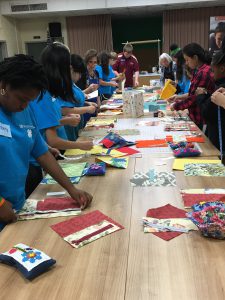
4-H Sewing Campers Photo source: Heidi Copeland
Think of all the things learned while sewing. Sewing helps teach:
- Finger dexterity and the development of fine motor skills.
- The value of patience.
- Systematic following of directions – both verbal and written.
- Creativity!
- Vocabulary as well as techniques.
- Pride in accomplishment for a job well done!
Moreover, sewing truly integrates science, technology, engineering, art and math (STEAM). And it is FUN! Campers:
- Learned first-hand about fibers (science).
- Experienced technology using various sewing machines and equipment – some even computer driven.
- Became adept at trouble shooting their own machine repair (engineering).
- Artistically bedazzled their creations.
- Utilized practical applications of many mathematical concepts to measure and sew as well as critical thinking and problem solving.
The 4-H Club pledge says, “I pledge … My Head to clearer thinking, My Heart to greater loyalty, My Hands to larger service and My Health to better living for my club, my community, my country, and my world”. ALL of the campers contributed to a community service project sewing a pillowcase destined for the Early Learning Coalition of the Big Bend Read a Child to Sleep campaign. This fostered the idea that empathy, sharing, nurturing relationships and giving is important too.
Sewing certainly did not stop when camp ended. A budding entrepreneur posted on Facebook she is taking orders for her creations while another camper is helping a local theatre group fashion costumes to obtain her community service hours fulfilling a high school graduation requirement.
There is no better feeling than the pride of accomplishment. Sewing campers learned by doing and while they were at it learned a skills they will carry throughout life.
To find out more about the American Sewing Guild: https://www.asg.org/
To find out more about Leon County 4-H programs: http://leon.ifas.ufl.edu/4h
If you are interested in learning more about 4-H, go to florida4h.org.

by Kendra Hughson | Apr 10, 2018
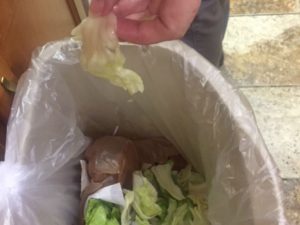
Save money and the environment by reducing the amount of food thrown in the trash. Credit: Kendra Zamojski
A hot topic in kitchens and restaurants these days is food waste. Chefs, restaurant managers, and even consumers are looking for ways to save money and the environment by reducing the amount of food tossed in the trash.
The United States Department of Agriculture estimates about 31% of food is lost at the retail and consumer level. Much of this food loss ends up in the landfill. The USDA is challenging consumers to reduce, recover and recycle their food waste.
The Basic Level:
If you know your family is tossing a lot of food in the trash and you want some easy ways to reduce the waste, try these:
- Plan your meals using foods you already have on hand and choosing foods you know you will use before they go bad. Substitute ingredients to include food you already have in the pantry or refrigerator.
- Create grocery lists using your family meal plan and checking for foods you already have on hand.
- Plan to use or freeze leftovers for dinners or lunches throughout the week.
- Watch what is being tossed and reduce your purchase of these items.
The Intermediate Level:
If your family is already good at the basic level and you want to take food waste reduction to the next level, try these steps:
- Make food purchases with packaging in mind. Choose items with minimal packaging.
- Store foods properly, with food safety in mind. Use food storage guides to properly store food items safely.
- Freeze what you can’t use in time. Follow these guides for freezing vegetables and freezing prepared foods:
- Use edible parts that you don’t usually eat when it’s safe. For example, save broccoli stalks and stems or potato peels for use in soups and casseroles.
Food Recovery Level:
If your family is ready to divert food from the landfill, try these steps:
- Compost your food waste. Contact your local Extension office for more information. Check out this resource on composting.
- Donate unused, unspoiled food.
Next time you throw food in the trash, take a minute to think about taking the challenge to reduce food waste. A few easy steps can help save your family money and the environment for future generations to enjoy.
Kendra Zamojski is a Regional Specialized Agent in Family and Consumer Sciences with the University of Florida/IFAS Extension. For more information, contact Kendra at hughson@ufl.edu.
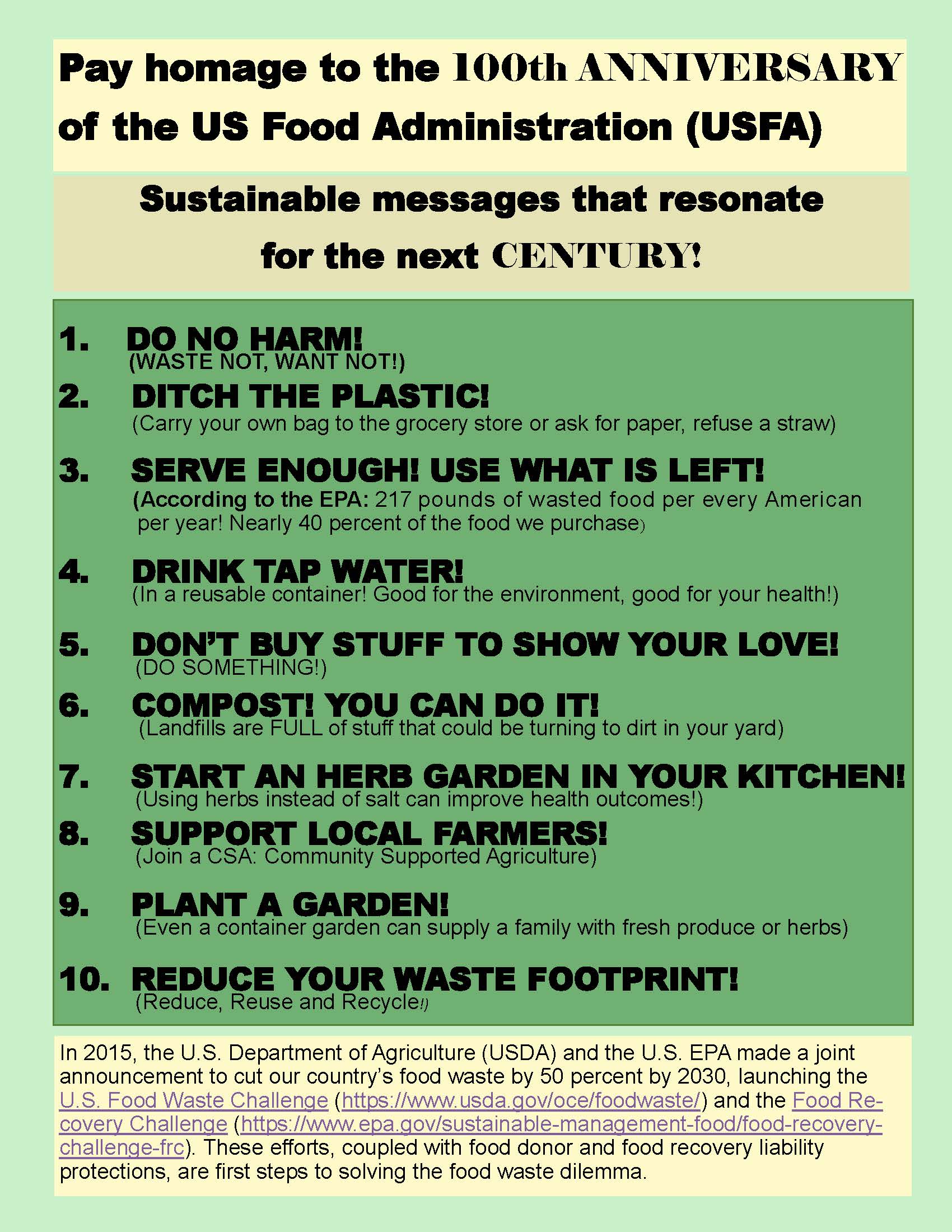
by Heidi Copeland | Mar 2, 2018
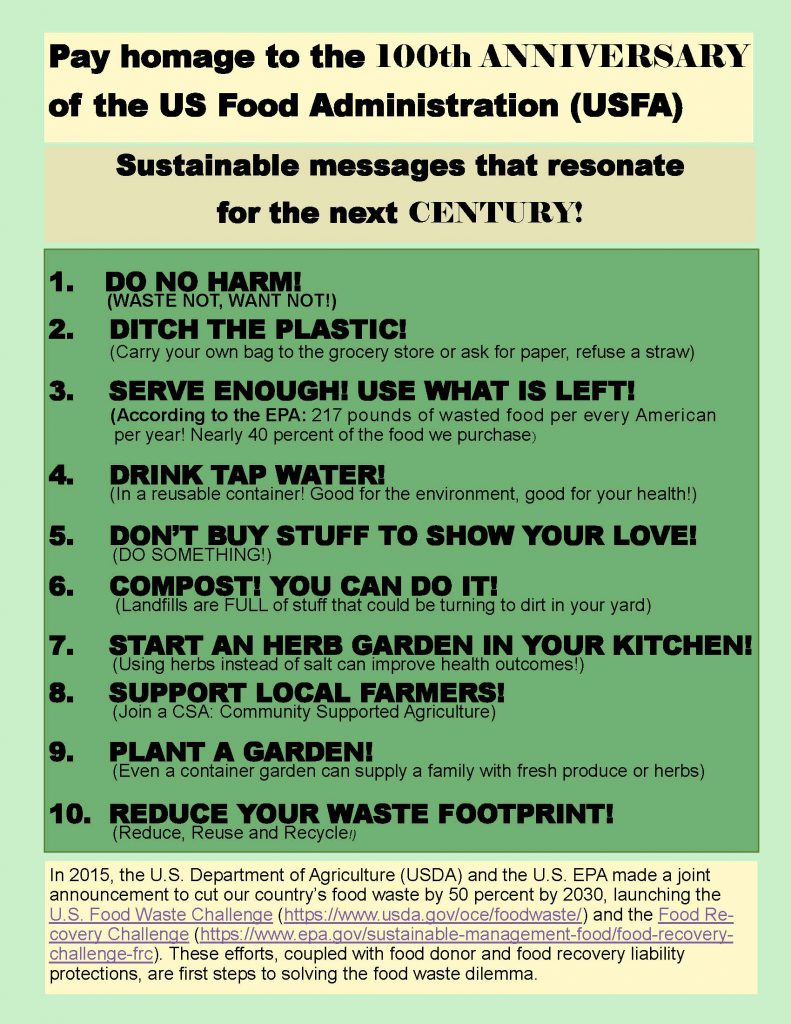
Photo credit: NW Extension District
Sustainability!
According to the Environmental Protection Agency (EPA), the term sustainability has emerged because of significant concerns about the unintended social, environmental, and economic consequences of our world’s rapid growth. Sustainability is based on the simple principle: Everything we need for our survival and well-being depends, either directly or indirectly, on our natural environment. Therefore, sustainability creates and maintains the conditions under which humans and nature can exist in harmony, fulfilling the social, economic, and other requirements of present and future generations.
WHEW! A mouthful, to be sure. Nevertheless, issues of sustainability are often overlooked on the individual level.
Did you know that during the United States’ (US) participation in World War I (from 1917 – 1918), the US had a US Food Administration (USFA) agency? This agency was responsible for food distribution to the US Army overseas and the Allies’ food reserves. This agency also organized a campaign to encourage Americans to support this effort through individual food conservation messages, media campaigns, and food education programs.
Now, 100 years later, this food conservation effort is still applicable.
Everyone can do his or her part in combating waste of all kinds. According to the USDA, reducing consumer-level loss is an important step toward reducing food waste in the United States. USDA estimates that almost 30 percent of the available U.S. food supply was lost from human consumption at the retail and consumer levels.
Every one of us can promote practices to strengthen our natural environment and quality of life. Even the EPA has some suggestions for reducing personal food waste:
- Shop your refrigerator first! Cook or eat what you already have at home before buying more.
- Plan your menu before you go shopping and buy only those things on your menu.
- Buy only what you realistically need and will use. Buying in bulk only saves money if you are able to use the food before it spoils.
- Be creative! If safe and healthy, use the edible parts of food that you normally do not eat. For example, stale bread can be used to make croutons and beet tops can be sautéed for a delicious side dish.
- Freeze, preserve, or can surplus fruits and vegetables – especially abundant seasonal produce.
- At restaurants, order only what you can finish by asking about portion sizes and be aware of side dishes included with entrees. Take home the leftovers and keep them for your next meal.
- At all-you-can-eat buffets, take only what you can eat.
Reducing food waste – a simple action of sustainability. Let’s give it a try! And pay homage to this 100-year-old sustainability campaign that can resonate for the next century.
For more information, visit https://www.usda.gov/oce/foodwaste/resources/consumers.htm and
http://edis.ifas.ufl.edu/fy1134

by Angela Hinkle | Oct 27, 2017
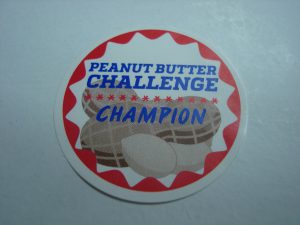
Peanut Butter Challenge Champion
Picture credit: Angela Hinkle
So you say you never win anything? Taking the Peanut Butter Challenge is a competition you’re guaranteed to win.
You can help feed the hungry in Florida’s Panhandle this year by donating peanut butter during the annual Peanut Butter Challenge, coordinated by UF/IFAS Extension. Thanks to a partnership between UF/IFAS Extension and the Florida Peanut Producers Association, food pantries from Pensacola to Monticello will receive thousands of jars of donated peanut butter this December.
From October 1 through November 22, you can donate unopened jars of peanut butter at your UF/IFAS Extension county office. Since 2012, UF/IFAS Extension faculty and volunteers have collected jars of peanut butter from residents, volunteer groups, and businesses in 16 northwest Florida counties. Last year, UF/IFAS Extension county offices received 3,236 jars of peanut butter! In addition to these donations, the Florida Peanut Produces Association also contributes, supplying more than 3,000 jars each year to the Challenge.
We hope to surpass last year’s total! This year, citizens throughout the Florida Panhandle counties are asked to help by donating peanut butter and becoming Peanut Butter Challenge Champions.
“The Peanut Butter Challenge not only raises awareness about the important contribution of North Florida’s peanut growers to the state peanut industry, but also helps provide a healthy, locally produced product to food-insecure families in northwest Florida,” said Libbie Johnson, Agricultural Agent in Escambia County.
Why peanut butter? Peanut butter is the most requested item at food pantries. See https://youtu.be/fPFvSgzmM3Y to learn more. A serving of peanut butter is loaded with protein, vitamins, minerals, fiber, and “good” fats. Peanut butter is a shelf-stable item – meaning it does not have to be heated or refrigerated. And people really like the taste.
How do you become a Peanut Butter Challenge Champion? Look for peanut butter BOGOs and other discounted sales at your local stores. Keep a jar for yourself and give the other unopened jar(s) to the Peanut Butter Challenge.
Voila! Everyone’s a winner! And you may proudly say, “I am a Peanut Butter Challenge Champion!”
by Melanie Taylor | Apr 3, 2017
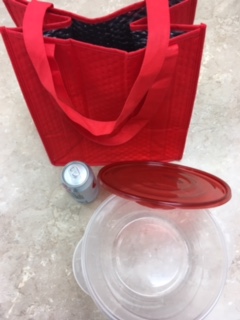 Do you remember the 3 R’s? If you are over the age of forty you are probably thinking of a classroom, a teacher, and learning about Reading, wRiting, and aRithmetic. These are the basic standards for learning, of course. However, it is now 2017and the 3 R’s have a new meaning to a new generation of young people: Reduce, Reuse, Recycle!
Do you remember the 3 R’s? If you are over the age of forty you are probably thinking of a classroom, a teacher, and learning about Reading, wRiting, and aRithmetic. These are the basic standards for learning, of course. However, it is now 2017and the 3 R’s have a new meaning to a new generation of young people: Reduce, Reuse, Recycle!
In today’s society, we constantly hear concerns about the environment and how we need to implement changes to make a positive impact upon its future. It is nearly impossible to pay attention to any media without feeling bombarded by messages of conservationism. “Go Green!” “Green… it’s the new black.” “Reduce, Reuse, Recycle.” However, are these sentiments new? Think about it. “Give a Hoot… Don’t Pollute.” “Keep America Beautiful.” “Keep Our Forests Green.” The use, or abuse, of our natural resources has long been an issue debated by our nation. It has more or less been the price we have had to pay for progress; but regardless of one’s political views and beliefs, the fact that Earth is the only planet that will sustain human lives is a hard fact to deny. It is therefore critical that everyone promote principles of conservationism for our future generations.
The practice of reducing, reusing, and recycling may be easily incorporated into many aspects of your everyday lives. As YOU reduce, reuse, and recycle in your daily lives, you will be teaching by example to your own children at home. Knowing that youth learn by seeing and doing, they will be much more likely to implement the practices of reducing, reusing and recycling into their own daily lives if they see you practicing the 3 R’s in yours.
How does the Environmental Protection Agency describe each of the 3 R’s?
Reduce the amount and toxicity of trash you throw away. One way is to turn off or unplug lights during the day. Doing so will save energy and help your lights last longer. Use food scraps, yard trimmings, and other organic wastes to create a compost pile. Adding the compost you make to soil increases water retention, decreases erosion, and keeps organic materials out of landfills.
Reuse containers and products. There are many creative ways to reuse items, which might normally find their way into the waste stream: old shoeboxes may be used for storage, plastic containers for planters, etc. You can also donate or give away items rather than throwing these items away. For a large number of unwanted items, you can hold a garage sale. It is also encouraged to shop at garage sales before buying new!
Recycle as much as possible and buy products with recycled content. Recycling includes collecting, sorting and processing certain solid waste into raw materials for re-manufacture into new items. These all help to cut down on the amount of waste we throw away. They conserve natural resources, landfill space and energy.
In addition, the three R’s save land and money communities must use to dispose of waste in landfills.These are all things we can do daily with just a little thought and effort. In fact, businesses are making it easier for us every day. We can reduce our trash in many ways, but an easy way is to reuse water bottles instead of throwing them away after each use. We can use the reusable bags that many stores now offer for our purchases; this is a great alternative to using plastic shopping bags. Of course, we can all make more of an effort to recycle by collecting our newspapers, aluminum cans, plastic bottles and glass jars for local recycling centers. If there are not recycling centers in your area maybe you should start one or pursue your community leaders about the importance of having one.
A few points to consider…
- The average American produces about 4.5 lbs. of garbage per person per day. This equal 235 million tons a year.
- Recycling 1 ton of paper saves 17 mature trees.
- Recycling 1 aluminum beverage can saves enough energy to run a 100 watt light bulb for 20 hours, a computer 3 hours, or a TV for 2 hours. (Currently, 45% of aluminum cans are recycled.)
- Reduce and reuse by donating old clothes and items to charities.
By instilling the importance of the 3 R’s into today’s society we will be helping clean the planet for the future. After all, “A true conservationist is a man who knows that the world is not given by his fathers but borrowed from his children.” As quoted by John James Audubon.
Source:
United States Environmental Protection Agency , https://www.epa.gov












